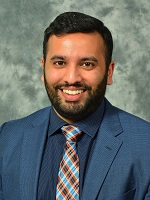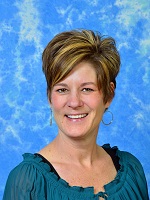17 Feb UND puts on a (free) clinic
An interprofessional team of health students and local providers partner on building a student-led, free clinic in Grand Forks
UND medical students, led by Dr. Eric Johnson, held a free clinic at a picnic in University Park last September. Photo courtesy of UND School of Medicine & Health Sciences.
When Dr. Eric Johnson and his team of first- and second-year medical students set up their blood glucose and blood pressure gear at the Welcoming Community Picnic at University Park in Grand Forks this past September, they had little idea how many patients they would be seeing.
Hundreds of patients later, the small volunteer group was exhausted, if relieved.
“We had one patient whose blood pressure was so high we sent him right to the emergency room,” said Johnson, associate professor in the UND School of Medicine & Health Sciences (SMHS) Department of Family & Community Medicine. “What if we hadn’t been there to catch that?”
The popularity of such an event begs another question among SMHS faculty and students: Should there be a standing free clinic that can take on patients without access to the health system otherwise, and if so, how might the SMHS be involved?
Meeting a Need
Answering that question has been Pranish Kantak’s mission, almost since he began as a first-year medical student at UND in 2017.
“When I was in grad school in North Carolina, I saw that UNC Chapel Hill had the largest student-run free clinic in the country,” explained Kantak, now in his third-year, over the phone from Fargo, N.D., where he is in the middle of his clinical rotations. “It started in 1951. So, when I came to UND, I was in my first block [of medical school] and set up a meeting with Dr. Dorscher to ask why we didn’t have one.”
“It’s true that many medical schools have this type of program already,” said Dr. Joycelyn Dorscher, the School’s associate dean for Student Affairs & Admissions. “The reason we don’t is that we only have students here for two years. At other schools, you have third- and fourth-year students you can bring into the process and increase the volunteers you have to work with. But we send most of ours out of Grand Forks.”
In other words, because the SMHS is one of only 28 community-based medical schools in the country that don’t own or operate their own hospital or clinic, the School’s third-and fourth-year medical students are sent to clinical locations across North Dakota to complete their final two years of education. That arrangement means anyone working to create a free, student-led clinic in Grand Forks must work especially hard to find not only appropriate space to house a clinic, but has a reduced pool of (student) volunteers to staff the clinic.
Interprofessional Education
“One of the things that I think is so incredible about this program [Kantak] is starting is that he’s being so inclusive of many other programs — nursing and social work and these things,” Dorscher continued from her office in the SMHS.
As Dorscher implies, the SMHS has put interprofessional education at the core of its curricula since 2006.
For example, the School offers an Interprofessional Health Care Course (IPHC) — taught by Dr. Johnson and faculty from other professions — twice per semester not only for medical students but those in nursing, physical and occupational therapy, counseling psychology, social work, nutrition & dietetics, and communication sciences & disorders. The course introduces students from each of these backgrounds to the roles played by other health care professionals in the same system.
“The idea is that this will help students learn how to work in an interdisciplinary team, which is how you function on the wards anyway,” Kantak said.
In line with this philosophy, he made an effort to reach out to students from the health sciences to make sure they’re also involved in the volunteer clinic. Thus, the effort is led by a multidisciplinary steering committee.
“We see this as a community need for those who don’t have insurance — a place where people can get some care so they don’t end up in the emergency department with something major that came from something minor that could’ve been caught earlier,” added Michelle Montgomery, wellness advocate at the SMHS and a key player in the School’s interprofessional training module. “But it’s also an opportunity for students from nursing, social work, physical therapy, and occupational therapy to have an interaction experience now, as students, to learn the value of working in teams.”
Public Health as Community Health
It seems those providers actually working in teams in the field agree.
“Our involvement has been to encourage the effort by students to consider total population health, address the social determinants of health in their interventions, and to work across disciplines,” noted Grand Forks Public Health Director Debbie Swanson, a nurse by training, of her early involvement in the clinic. “I had some early email messages with Pranish and helped to get a meeting arranged that included Mara.”
That’s Mara Jiran, CEO of Spectra Health, a community health center based in Grand Forks and Larimore, N.D., dedicated to seeing that high-quality health services are available to everyone in northeast North Dakota.
According to Jiran, Spectra Health supports not only projects like Kantak’s but a series of UND interprofessional projects, including the School’s physical therapy clinic, a women’s health rotation for medical students, and various internships for UND nursing, pre-medicine, pre-dental, counseling psychology, Master of Public Health, and social work students.
“We are finding that fewer people lack access to care since the Affordable Care Act was fully implemented and Spectra has expanded,” continued Swanson, noting also that Grand Forks-based provider Altru Health System has been involved in the project. “Yet, there are people who have difficulty navigating the system and a few disenfranchised groups that lack coverage, such as those recently incarcerated. I’m hopeful a student-run clinic can help fill those gaps.”
Location, Location, Location
In the end though, and to illustrate Swanson’s point, the biggest challenge Kantak has faced has been finding space.
“The issue that remains is how to handle emergency cases, should they present,” said Kantak, noting that overcoming hurdles such as coding and medical record-keeping has been relatively easy. “If someone comes in and needs an emergency procedure or referral on a site, who manages that and who pays? Whose responsibility is it to care for that serious case? That’s been our largest challenge — finding a place to do it all.”
But assuming finding reliable space is likely, a clinic setting should be forthcoming, Kantak said, especially for non-emergent cases.
After all, there is precedent for such a space in the community; for many years, Third Street Clinic in downtown Grand Forks provided access for patients weekly. Although that nonprofit still exists, it operates under a different model today, connecting patients to care off-site and providing them with medication assistance.
“There’s still a need for clinical care for patients who don’t want to go to the emergency department,” concluded Kantak. “There’s a place for this type of clinic, both for patients and educators helping to train future providers.”
About the author

Brian James Schill is the assistant director of the Office of Alumni and Community Relations at the University of North Dakota School of Medicine & Health Sciences.





